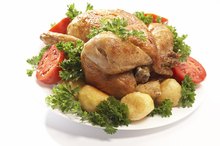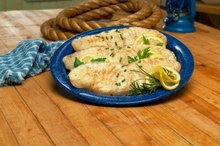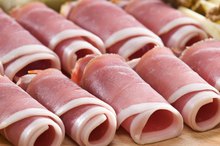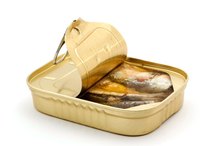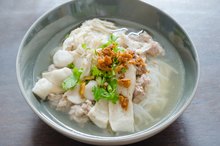Nutritional Facts for Ahi Vs. Yellowfin Tuna
Two types of tuna fish are commonly sold as "ahi" tuna. These are yellowfin tuna and bigeye tuna 2. Yellowfin tuna are fished in most areas of the world, apart from the Mediterranean Sea. Bigeye tuna are caught in cool, deep waters of the Pacific Ocean. Bigeye has a higher fat content, but is preferred over yellowfin by sashimi connoisseurs. Consult your doctor before making significant dietary changes.
Tips
Ahi Vs Yellowfin Tuna has 106 Calories and 24.78 g of Protein per 100 gram serving according to the nutrition facts provided by the USDA Food Composition Database.
Yellowfin Tuna Nutritional Facts
Raw yellowfin tuna contains 109 calories in every 100 g, or 3.5 oz. serving. The fish is virtually fat-free, with only 0.5 g of fat per serving. There are 24.4 g. of protein in 100 g of uncooked yellowfin, but no carbohydrates, sugars or dietary fiber. When yellowfin tuna is cooked over a dry heat, it contains 130 calories and 29.2 g. of protein in every 100 g serving. The water loss associated with dry-heat cooking is the reason for this change in nutrient composition.
- Raw yellowfin tuna contains 109 calories in every 100 g, or 3.5 oz.
- When yellowfin tuna is cooked over a dry heat, it contains 130 calories and 29.2 g. of protein in every 100 g serving.
Bigeye Tuna Nutritional Facts
How to Defrost Frozen Swordfish
Learn More
A 100 g, or 3.5 oz., serving of cooked bigeye ahi tuna contains 108 calories. The protein content of bigeye ahi is 24 g. There are no carbohydrates including dietary fiber or sugar present in the bigeye tuna flesh, but there are 45 mg of cholesterol in every 100 g of cooked fish. The same portion contains 40 mg of sodium, roughly 1 percent of the recommended daily adult intake.
Fat and Cholesterol
Both types of tuna are low-fat foods. A cooked 100 g serving of bigeye ahi contains 2 g of fat, while the same portion of cooked yellowfin tuna typically contains 0.6 g of fat. However, the overall fat content of yellowfin tuna becomes higher as the size of the individual fish increases. For larger fish, bigeye ahi tuna may be significantly lower in fat The cholesterol content of bigeye ahi tuna is very slightly less than that of yellowfin, with 45 mg per 100 g serving instead of yellowfin's 47 mg.
- Both types of tuna are low-fat foods.
- For larger fish, bigeye ahi tuna may be significantly lower in fat The cholesterol content of bigeye ahi tuna is very slightly less than that of yellowfin, with 45 mg per 100 g serving instead of yellowfin's 47 mg.
Use in Japanese Cuisine
Fish & Chicken Diet
Learn More
Both sushi and sashimi are fish-based Japanese dishes. Sushi refers to sliced fish, usually raw, wrapped in or served over sushi rice. Sashimi is made up of only the fish, usually raw, and cut in very thin slices. Bigeye ahi tuna is preferred over yellowfin for use in sashimi and sushi dishes 2. This is because yellowfin perishes more quickly than bigeye ahi tuna. The slightly richer, deeply-colored flesh of raw bigeye ahi results in a price premium for bigeye over yellowfin tuna for sushi and sashimi 2.
- Both sushi and sashimi are fish-based Japanese dishes.
- Bigeye ahi tuna is preferred over yellowfin for use in sashimi and sushi dishes 2.
Related Articles
References
- USDA National Nutrient Database for Standard Reference, Release 23
- Difference Between.net: Difference Between Ahi and Yellowfin Tuna
- Food-Info.net: What is the Difference Between Sushi and Sashimi?
- Fish, tuna, light, canned in water, without salt, drained solids. FoodData Central. U.S. Department of Agriculture. Published April 1, 2019.
- Dhurmeea Z, Pethybridge H, Appadoo C, Bodin N. Lipid and fatty acid dynamics in mature female albacore tuna (Thunnus alalunga) in the western Indian Ocean. PLOS ONE. 2018. doi:10.1371/journal.pone.0194558
- Vitamin B12 or folate deficiency anaemia. National Health Service. Updated 2019.
- Sparkes C, Gibson R, Sinclair A, Else PL, Meyer BJ. Effect of low dose docosahexaenoic acid-rich fish oil on plasma lipids and lipoproteins in pre-menopausal women: A dose⁻response randomized placebo-controlled trial. Nutrients. 2018;10(10). 10.3390/nu10101460
- Simonetto M, Infante M, Sacco RL, Rundek T, Della-Morte D. A novel anti-inflammatory role of omega-3 PUFAs in prevention and treatment of atherosclerosis and vascular cognitive impairment and dementia. Nutrients. 2019;11(10). doi:10.3390/nu11102279
- Damanti S, Azzolino D, Roncaglione C, Arosio B, Rossi P, Cesari M. Efficacy of nutritional interventions as stand-alone or synergistic treatments with exercise for the management of sarcopenia. Nutrients. 2019;11(9). doi:10.3390/nu11091991
- Diabetes superfoods. American Diabetes Association. Updated 2020.
- Histamine toxicity. American Academy of Allergy, Asthma & Immunology. Updated 2020.
- ACOG practice advisory: Update on seafood consumption during pregnancy. American College of Obstetricians and Gynecologists. Updated 2017.
- Canned tuna. Seafood Health Facts: Making Smart Choices Balancing the Benefits and Risks of Seafood Consumption. Updated 2020.
- Selecting and serving fresh and frozen seafood safely. U.S. Food and Drug Administration. Updated 2019.
Writer Bio
Jae Allen has been a writer since 1999, with articles published in "The Hub," "Innocent Words" and "Rhythm." She has worked as a medical writer, paralegal, veterinary assistant, stage manager, session musician, ghostwriter and university professor. Allen specializes in travel, health/fitness, animals and other topics.

